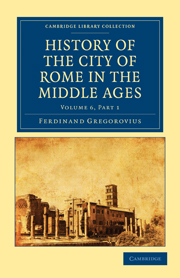CHAPTER I
Published online by Cambridge University Press: 05 October 2010
Summary
The history of the fourteenth century describes the decay of the feudal and hierarchical institutions of the Middle Ages. These two universal forms, the Church and the Empire–creations of the Latin idea of human society as a universal monarchy–now appear in entirely altered relations, languishing and threatened with ruin. The ancient German-Roman empire had already perished with the Hohenstaufens, had fallen into vassalage to the Church, and had been banished from Italy. But scarcely had this occurred, when the ancient hierarchical Church suffered a like fate. The popes forsook Italy in the beginning of the fourteenth century. Frenchmen as they were, they entered the service of France and were robbed of their universal dominion.
The exile to Avignon was followed first by the schism, then by a general Council, lastly by the Reformation.
When the gigantic struggle of the Middle Ages between the spiritual and secular powers was fought out, no mission of universal importance to the European world remained to the popes. The absolute dominion which they had acquired in the thirteenth century, they turned with suicidal policy against themselves and the Church. They corrupted the Church by countless abuses. Even in their impotence at Avignon under the protection of France, the popes, who acquired their great international position solely through opposition to the empire, again evoked the ancient war.
- Type
- Chapter
- Information
- History of the City of Rome in the Middle Ages , pp. 1 - 61Publisher: Cambridge University PressPrint publication year: 2010First published in: 1898



